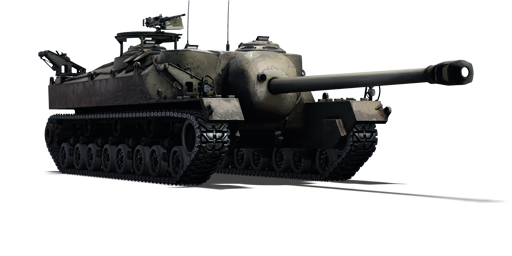



In 1943, the US Army recognised the need for an assault tank capable of defeating enemy fortifications, particularly the German Siegfried Line, while having sufficient armour to resist any returning fire. As such, development of the Super Heavy Tank T28 began that same year. The T28 featured extremely thick all-around armour, with frontal armour of 305 mm, and was equipped with a powerful 105 mm T5E1 anti-tank gun. Since speed was not a priority, the T28 had a top speed of just 13 km/h. To cope with its massive weight and ground pressure, the T28 was equipped with a second set of tracks which could be removed for rail transport. By the time two prototypes entered testing in 1945, the Siegfried Line had already been broken. This, along with the realisation that such a heavy vehicle was impractical in combat, led to the cancellation of the project in 1947. The sole remaining prototype is currently preserved at the US Army Armor and Cavalry Collection at Fort Benning, Georgia.
As a side note, the name "Heavy Tank T28" was changed to “105 mm Gun Motor Carriage T95” in March 1945 because its unique turretless design did not fit with the then definition of a “tank”. However, the tank was again redesignated “Super Heavy Tank T28” in June 1946 as the vehicle was too heavily armoured compared to conventional SPGs, effectively making the T28/T95 a one-of-a-kind vehicle. In War Thunder, the name "T28" is used to refer to the “transport” version of the tank without the extra tracks.
The T28 was introduced in Update 1.49 "Weapons of Victory". Due to the lack of the extra sets of tracks on the T95, the T28 suffers from excessive ground pressure, resulting in extremely poor overall mobility. Despite the tank being 26 tons lighter, the T28 remains very slow and therefore very vulnerable to close-air support. The absence of reinforced side armour means that the T28 is much more vulnerable to attack from the sides. However, the T28 still retains the powerful gun and thick frontal armour from the T95, allowing it to push towards targets, provided that the flanks are properly covered.
| Ammunition | Type | Armor penetration (mm) at a distance: | |||||
|---|---|---|---|---|---|---|---|
| 10 m | 100 m | 500 m | 1000 m | 1500 m | 2000 m | ||
| APCBC | 256 | 253 | 238 | 221 | 205 | 190 | |
| HE | 27 | 27 | 25 | 23 | 21 | 20 | |
| APCBC | 253 | 250 | 236 | 219 | 204 | 190 | |
| APCR | 292 | 287 | 266 | 242 | 220 | 200 | |
| Belt | Belt filling | Armor penetration (mm) at a distance: | |||||
|---|---|---|---|---|---|---|---|
| 10 m | 100 m | 500 m | 1000 m | 1500 m | 2000 m | ||
| API-T/I/AP/API-T | 31 | 29 | 21 | 14 | 9 | 6 | |







 2 x (135 / 205 / 250) %
2 x (135 / 205 / 250) % 
 2 x 184 %
2 x 184 % 

Mobility | |
|---|---|
Protection |
|---|
Firepower | |
|---|---|